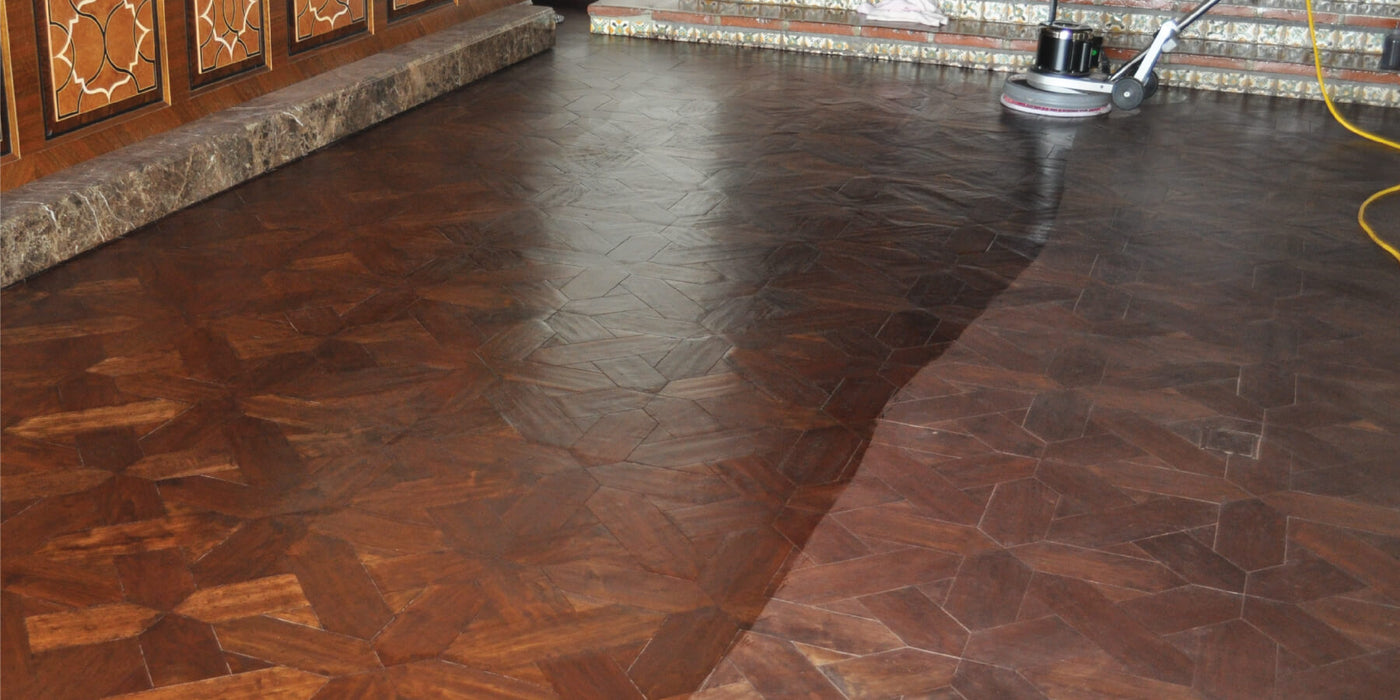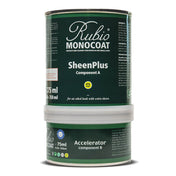When to renovate
A “renovation” is necessary when color restoration is required. If color restoration is not required, maintenance is done using Renew.
For an overview of the care process, please read caring for your Rubio Monocoat oil finished floor.
Under normal circumstances, a floor that has been properly cared for should not need a renovation.
There are a couple cases though, where a renovation is required.
- If cleaning and/or maintenance is neglected, the protective qualities of the finish can become compromised and further use can result in loss of color.
- When the recommended cleaner (Rubio Monocoat Surface Care Spray or properly diluted Rubio Monocoat Soap) is not used, appearance and performance issues can be expected. Both of these situations will require a “renovation” application using Oil Plus 2C to restore the appearance and protective properties of the floor.
How a renovation works
You may be asking yourself, doesn’t the Rubio Monocoat Technology, that prevents lap lines, mean that simply introducing more product will not work because the surface will not accept more product? And you would be correct.
The trick to the renovation process is a light abrasion that opens the initially applied Oil Plus 2C finish. This means a renovation can be performed without requiring a full-on re-sand. Once abraded and cleaned, apply Oil Plus 2C the same way as an initial application.
During application, only the areas that require color restoration will accept color while the remaining areas will simply be refreshed in appearance and protection.
Let’s take a closer look at the renovation process!
Things used for an RMC Oil Plus 2C Renovation
- Rubio Monocoat Surface Care Spray (or properly diluted Rubio Monocoat Soap)
- Electric floor buffer
- Maroon buffing pads (ScotchBrite material in 240-320 grit)
- White buffing pads
- Rubio Monocoat Applicator Set
- A vacuum cleaner
- Plenty of good absorbing terry cloths/towels
- Enough Rubio Monocoat Oil Plus 2C in original applied color
- A clean mixing container
- Stir stick
- A measuring device
- Easy release painters’ tape
- Nitrile gloves
- Water filled, metal can, with a lid for safe disposal of oil-contaminated rags and pads.
Preparation process
- Vacuum the floor to remove all loose debris and dirt.
- Clean the floor thoroughly using Surface Care Spray. You may use the aid of a white buffing pad along with Surface Care Spray to help loosen stubborn dirt.
- Allow the cleaned surface to dry.
- Lightly scuff the cleaned wood floor with a maroon buffing pad.
- The outside floor perimeter gets done by hand.
- The floor's field is abraded with the help of an electric buffer. For a wood floor with a textured surface, like a hand-scraped floor, you may want to back up the conditioning pad with a thick buffer pad between the driver and conditioning pad to accommodate for the uneven surface.
- Vacuum the abraded floor thoroughly.
- Tack the floor with a dry mop or a water-dampened mop/rag.
- Allow the tacked floor to dry completely.
- If desired, prior to oiling the floor, mask the baseboards, door jambs, and cabinets with easy release painters' tape to avoid getting oil on them.
Damage repairs (Optional)
Minor scratches and nicks where the wood is exposed are best reoiled with Oil Plus 2C during the renovation process and typically do not require more than that. Such minor blemishes (once re-oiled) become part of your floors' natural patina, just like with a nice piece of leather furniture.
Significant scratches or gouges in your wood floor that are undesirable may need fixing first. If a fix is desired/required, follow the below process.
- Scrape and sand the damage out until flush. Sometimes a board replacement is required when the damage is too extensive.
- Blend the repair area's transition with each board's grain flow pattern or sand the entire board down to bare wood, up to a natural joint.
IMPORTANT: Sanding must mimic the original sanding process to ensure consistent color results. - Vacuum the surface.
- Clean using Raw Wood Cleaner.
- Allow to dry (approx. 15-60 minutes).
- Apply Oil Plus 2C in the original color to the raw wood area. Work the oil into the wood in a circular motion using the Rubio Monocoat Applicator Set.
- Allow the oil to react for 3-5 minutes.
- Remove all excess oil from the wood surface with a dry rag within 10-15 minutes.
- Clean the outside perimeter of the repair with a clean rag, blending the repair zone.
- Allow the oiled repair area to dry and cure for approximately 24-36 hours.
- Lightly rub-down the oiled repair area with a piece of the maroon buffing pad. This will blend the repair area in with the rest of the previously abraded floor.
- Remove all dust and proceed to overall renovation process.
Renovation process
Applying Oil Plus 2C for a renovation is the same as the initial application, with the exception of the spread rate. Because the wood is already mostly saturated, a renovation gets significantly better spread rates. Always aim for the lower spread rate when estimating product usage.
- Oil Plus 2C - 1.3 Liter (approx. 1400-1600 sq ft)
- Oil Plus 2C - 350 ML (approx. 370-430 sq ft)


